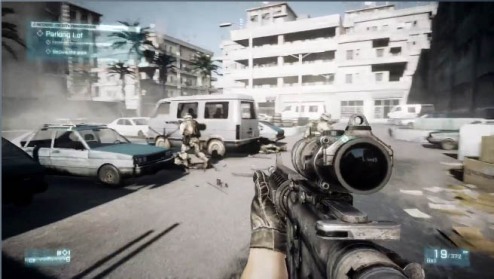Now that we’ve hit late August, most video game companies with triple-A titles debuting in just a few short months are starting to crank up their marketing campaign to eleven, most notably EA and Activision. Both companies will soon have a slew of commercials out there touting “real footage” of in-game scenarios so as to claim they have the top-tier graphics found nowhere else. Each time one of these “grudge” matches pops up, I keep wondering if this fight is even worth having. Honestly, take a look at an in-game picture of the upcoming Battlefield 3:
See this difference? If you can, you’re most likely lying. While I’m sure each game will have advantages over the other (MW3 will run at a solid 60fps, according to Activision), the particle effects, polygon counts, draw distance, and overall presentation are going to be so close to identical. Most of the gaming community won’t even notice or care all that much (the bottom line will always be game play, not graphics). It seems that, for the most part, video game graphics have approached a type of plateau. We might be able to squeeze a few more particles here and there every year, or increase the polygon cap by a few dozen, but other than that it’s about as good as it gets, right?
Enter Euclideon.
I found this video courtesy of Break.com, but it can also be found on their website along with several pictures and commentaries. According to the narrator (who is also the CEO), their company has been working on a new technology for several years that, if it works the way he claims, will truly be the next big step for video game graphics.
Now, the video is several minutes long and loosely describes the concept, so here’s my probably awful attempt at explaining it like he does: Instead of building an environment out of thousands of polygons and shaders, everything it built out of tiny bits of data they call “atoms.” By using these much smaller bits, each object comes out with a much higher level of detail, allowing the player to really get a sense of the object’s size and depth. Not stopping there, apparently even the dirt on the ground is made up of atoms. Instead of a virtual bottom glossed over with a wallpaper-looking ground, plants are trampled when walked over, dirt is shuffled into the air with each step, and much more. I did notice, however, that they neglect to mention the amount of computing power a technology like this would eat up. I’m no computer scientist, but managing bits of data at such a huge level each millisecond must amount to incredible levels of strain on a person’s processor and RAM. Hopefully, with another year’s worth of work, Euclideon will have something mighty impressive to start showing off, and I’d love to see what companies like Ubisoft, Suckerpunch or Valve could do with this level of detail. Only time will tell.
See you in the next level,
Gray




No comments:
Post a Comment
LEAVE A COMMENT